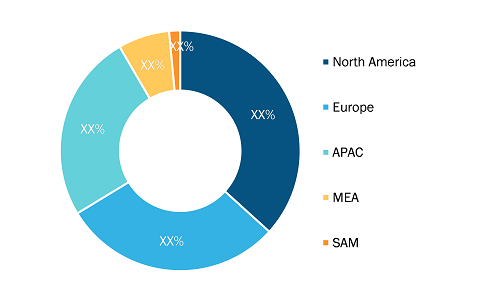The global time-of-flight sensor market size is expected to reach USD 8,426.63 Million by 2028; registering at a CAGR of 17.5% from 2022 to 2028, according to a new research study conducted by The Insight Partners.
Increasing Use of Time-of-Flight Technology in Autonomous Mobile Robots is Expected to Provide Growth Opportunities for Time-of-Flight Sensor Market during 2022–2028
Time-of-flight (ToF) sensors are used to measure the time taken by an object to travel a distance through a medium. It measures the time difference between the emission of a signal and its return to the sensor after being reflected by an object. The sensor is used for various applications, including robot navigation, people counting, vehicle monitoring, and object detection. It is an all-in-one system for cost-effective, easy, and small-footprint integration. It provides true distance measurement without depending on the target size, color, and reflectance. In addition, ToF sensors use lasers to measure long distances and ranges with great precision.
Time-of-Flight Sensor Market - by Geography, 2022
Time-of-Flight Sensor Market Forecast to 2028 - COVID-19 Impact and Global Analysis by Device Type (RF-Modulated Light Sources With Phase Detectors, Range-Gated Imagers, Direct Time-of-Flight Imagers); Vertical (Automotive, Consumer Electronics, Gaming and Entertainment, Industrial, Healthcare, Aerospace and Defense, Others)
Time-of-Flight Sensor Market Share, Size and Growth Report 2028
Download Free Sample
Source: The Insight Partners Analysis
The demand for ToF sensors is increasing due to their rising use in the automotive industry. The technology is used to monitor the driver's behavior that helps prevent road accidents and improve vehicle safety. In addition, the demand for the sensors is increasing in other industries, such as consumer electronics, healthcare, gaming & entertainment, and aerospace & defense. As a result, the market players are coming up with advanced ToF sensors. In February 2020, Panasonic Corporation announced that they had developed a time-of-flight image sensor that uses avalanche photodiode (APD) pixels. It can acquire highly accurate 3D information according to the position of objects from near to far distances up to 250 m. These sensors can be applied in various fields such as automotive range imaging and wide-area surveillance. Furthermore, the increasing use of time-of-flight technology in autonomous mobile robots is expected to create an opportunity for the time-of-flight sensor market during the forecast period. In addition, the growing adoption of time-of-flight sensors in smartphones for photography and 3D facial mapping for facial unlocking would fuel the time-of-flight sensor market growth in the coming years.
The time-of-flight sensor market growth in North America is attributed to the increasing demand for time-of-flight (ToF) sensors in automotive and consumer electronics applications. According to the American Automotive Policy Council (AAPC), the automotive industry in the US accounts for about 3% of the country's GDP. The ToF technology provides accurate and robust depth-sensing capabilities for a wide range of automotive applications within and beyond the vehicle. Inside the vehicle, the time-of-flight technology provides safety and comfort to the driver and passengers. A few safety functions provided by the ToF camera are NCAP-mandated driver fatigue detection, hands-on-wheel detection, body pose, eye gaze, head pose, and advanced seat-belt application. The safety function of the time-of-flight sensor helps prevent road accidents. Thus, owing to the rising awareness about safety functions, the demand for vehicles incorporated with the ToF camera is increasing in the North American market.
Since COVID-19 pandemic, the demand for smartphones, laptops, tablets, and other consumer electronic devices has increased in North American countries. Due to the growing consumer electronics industry, the demand for time-of-flight sensors is increasing across North America. The sensors consume low power, which also propels their demand in the market. Various smartphone producers are using time-of-flight technology in their smartphones. Apple Inc, the largest smartphone producer in the US, launched the iPhone 13 Pro in 2021, which consists of a ToF sensor. Thus, the growing adoption of ToF sensors in smartphones by US manufacturers is further fueling the growth of the time-of-flight sensor market in North America.
The time-of-flight sensor market is segmented into device type and vertical. Based on Device Type, the time-of-flight sensor market is segmented into RF-modulated light sources with phase detectors, range-gated imagers, and direct time-of-flight imagers. Based on Vertical, the time-of-flight sensor market is categorized into automotive, consumer electronics, gaming and entertainment, industrial, healthcare, aerospace and defense, and others.
Sony Group Corp, STMicroelectronics NV, Texas Instruments Inc, Teledyne e2v (Overseas) Holdings Ltd, OMRON Corp, InvenSense Inc, Panasonic Holdings Corp, Analog Devices Inc, Keyence Corp, and Infineon Technologies AG are a few key players profiled during the study on the time-of-flight sensor market. Several other major market players were studied and analyzed during time-of-flight sensor market research study to get a holistic view of the market and its ecosystem. The time-of-flight sensor market report provides detailed market insights, which helps the key players strategize their growth.
The US was the most affected country in North America by the onset of the COVID-19 pandemic. In 2020, strict regulations were imposed by the US government, due to which many electronics manufacturers were operating with a limited workforce or temporarily discontinued the production of electronic devices. This negative affected the supply chain and also the import and export of electronic products. However, in 2020, the demand for time-of-flight sensors increased in the healthcare industry which boost the growth of time-of-flight sensor market in the region. For instance, in January 2020, Arrow Electronics Inc introduced its first healthcare-focused proof-of-concept design, which incorporated 3D time-of-flight (ToF) technology for healthcare monitoring by Analog Devices, Inc. The design can be deployed to deliver highly accurate sensory data for monitoring breathing patterns and small motion detection. In addition, the growing automotive & consumer electronics industry in the US, Canada, and Mexico is further increasing the demand for time-of-flight sensors. Thus, from the Q1 of 2021, the supply lines of the automotive & consumer electronics industry started to stabilize, and the revenue of these industries showcased positive momentum, which propelled the time-of-flight sensor market in North America.
Contact Us
Phone: +1-646-491-9876
Email Id: sales@theinsightpartners.com